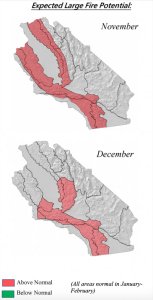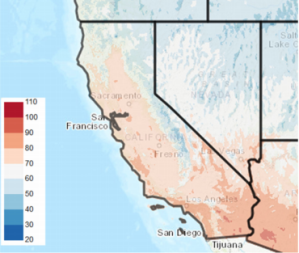
Last month’s firestorms that saw dozens of homes consumed by flames across Southern California was just the beginning of what’s expected to be a long, dry fire season for the region.
The potential for destructive blazes will remain higher than usual for the rest of the year, with above-average temperatures and weak rainfall extending tinderbox conditions, according to the latest seasonal outlook from the National Interagency Fire Center.
Temperatures are forecast to remain above average through early 2020, while wet weather is expected to arrive late this winter and will likely deliver below average rainfall.
There’s only a slight chance of more intense wind events than usual through the end of December, but winds that do come will have an easy time igniting a fire in exceedingly dry brush, experts say.
“This may be a long fall and winter across California for both the firefighting community and the general public in terms of coping with the threat of fires,” according to the Predictive Services wildfire outlook released Nov. 1.
Firefighters have already battled more than 10 destructive blazes this fire season in Southern California and thousands of residents were forced to flee their homes, over 100 of which wound up being destroyed.
The largest so far is also the most recent, Ventura County’s Maria Fire, which stood just shy of 10,000 acres Monday night after breaking out Oct. 31. It’s now 90% contained.
Officials fear the rest of the season could bring more of the same.
The report finds October’s flurry of fires sparked after the atmosphere seemingly “flipped a switch” at the end of September, with wetter wind patterns being replaced by dryer ones, possibly because atmospheric temperatures are beginning to sync with warmer temperatures in the Pacific.

Forecasters say it could be the beginning of another El Niño event.
Meanwhile, the warm, dry weather Southern California has been experiencing since September has left fuels dried out. The last few rounds of Santa Ana winds pushed dead brush moisture “toward the 90-95th percentile in terms of dryness,” while live vegetation is “close (to) or at critically dry levels,” the outlook states.
That means fires that do spark will be able to spread quickly and aggressively. The problem is widespread, since little summer rain fell anywhere in Southern California this year.
“A weather pattern which favors offshore winds occurring over fuel beds that are primed for burning will lead to above to well above normal large fire potential through November,” the report found, and the fire danger could linger throughout December.
The one glimmer of hope: Shorter daylight hours mean help make it easier to fight fires when winds are low. But on gusty nights, blazes may be able to smolder across several burn periods, which is not the norm for this time of year.
Officials advise residents to have a wildfire plan ready in case one ignites near their home.











